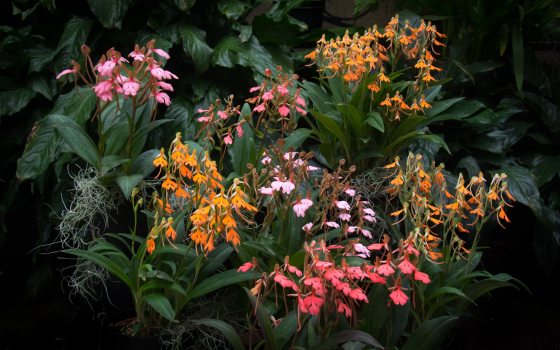What if you could hold in your hand a bouquet of 50 neon orange, bright pink, or coral-colored flowers, all on a plant that could fit inside your coffee cup? This is exactly what the genus Habenaria and its allied genera offer. At Longwood, we’re hybridizing this genus extensively, as there are a number of features that make Habenaria wonderful plants, both for our collection and display—as well as for the hobbyist and orchid home-grower. Relatively easy to grow once you understand their cultural requirements, Habenaria and their hybrids show great promise—and we’re pleased to share with you the beautiful results of recent hybrids that you can see here at Longwood, as well as how you can care for Habenaria at home.
Habenaria is a rather large genus, with almost 900 accepted species. Among those who grow and breed Habenaria, however, it is commonly acknowledged that this large genus that spans the entire world, from the southern United States through South America to Africa and Asia, is probably at least three separate (although related) genera. Most of the plants seen in cultivation and used in hybridization are primarily from southeast Asia, as these are the easiest to grow and some of the most vibrantly colored.
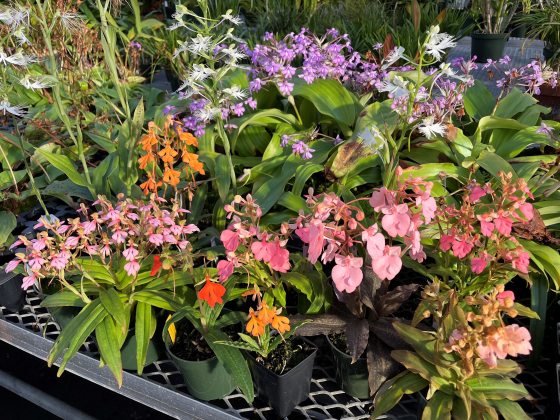
A group of breeding stock Habenaria alliance plants on the bench in the greenhouse. Photo by Greg Griffis.
Habenaria have a winter dormancy, when you barely water them at all—which can be intimidating at first, but in the end this actually makes them easy, as you don’t have to do anything with them for about four months! They are also wonderful plants because they are summer- and early fall- flowering—a time at which many of the other genera in the orchid world are growing and not flowering.
Habenaria begin their growth in the spring, and as the first shoots appear, it’s best to begin to water sparingly from the bottom of the pot (by sitting in a saucer of water, to avoid getting water in the crowns of the new shoots and rotting them). Once they have started to put out their third or fourth leaf, you can begin to keep them evenly moist throughout the remainder of their growth season, which encompasses the summer months. They will mature and flower towards the end of the summer or early fall (typically, although some will not mature until a little bit later these days), and once they have flowered, they will begin to die back. At this point it’s best to taper off watering until the growths have died off and then cease to water at all. Through the winter dormancy you may choose to give them a little moisture from time to time to ensure that they do not shrivel up and desiccate, but some find this is not necessary, especially if you follow some growers and unpot them during their dormancy, keeping them in plastic baggies over the winter with a little dry media.
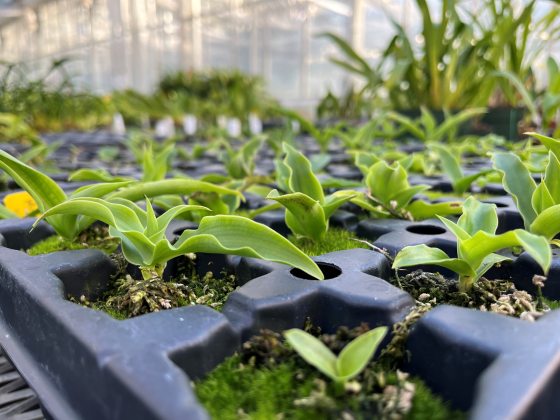
× Pectabenaria hybrid seedlings, just starting to push their way up out of the medium. Photo by Greg Griffis.
Habenaria can also be compact, but if you grow them well and allow them the room, they can become large specimen plants too! Most find they can grow them comfortably in 4- to 5-inch pots, and simply divide them when they begin to accumulate too many tuberoids and get too large for their space.
Of course, one of the most obvious attributes of the Habenaria alliance is its colors. From neon orange to bright pink, clarion yellows, and pristine whites, there is a lot to love in the colors of the Habenaria alliance. Now, more than ever, there are also intermediary colors, like corals and sunset tones, and we are beginning to see bicolor flowers, gradients, and blushes as well. With Habenaria you can have all that color in a small pot with lots of flowers. In a 4-inch pot you could have as many as five inflorescences, each carrying anywhere from ten to 20 flowers. That’s a lot of flower power!
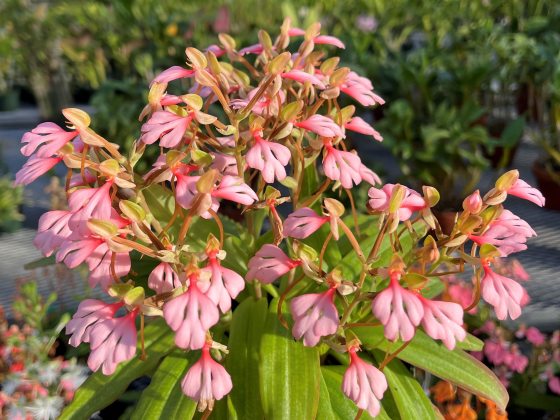
Habenaria Erich’s Pink Thing, with eight inflorescences in a 5-inch pot and more than 60 flowers. Photo by Greg Griffis.
For all these reasons and more, we have initiated quite a vigorous Habenaria alliance hybridization program here at Longwood, joining a handful of other active hybridizers in the US, South America, and southeast Asia. While our hybridization program at Longwood is still in its early stages, we have already made a few hybrids that are exciting and show promise.
Our first Habenaria hybrid that we registered is Habenaria Longwood Apricot, a cross of Habenaria Canary ‘Longwood’s Kumquat Queen’ x Habenaria rhodocheila ‘Nu’uanu’ FCC/AOS. We have seen a few outcomes from this cross, and the results are very good. The shape is improved, and the colors have ranged from clear orange to rich red. This year Habenaria Longwood Apricot ‘Longwood’s Blood Orange’ will be on display for a short time—about the next week—before it heads back to the bench to go to work breeding the next generation! We will also be remaking this cross, so that we can find more great seedlings in the future.
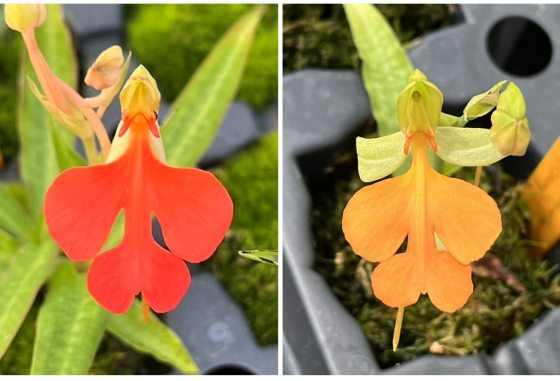
Habenaria Longwood Apricot ‘Longwood’s Blood Orange’ on the left, on view now in the Orchid House for a limited time (only for approximately the next week!); Habenaria Longwood Apricot ‘Longwood’s Tangerine’ on the right. Photos by Greg Griffis.
The next Habenaria hybrid that we registered is Habenaria Longwood Papaya. This is a cross of Habenaria Canary ‘Longwood’s Kumquat Queen’ x Habenaria Tracey ‘Longwood’s Sunset’. This cross has revealed incredibly good shape in some of the offspring, as well as a range of colors, from orange to pink, with coral tones in between. We will have some seedlings of this cross on display over the next couple weeks, and we will be remaking the cross with other clones of Tracey, as I believe that we can get even better results from different crossings.
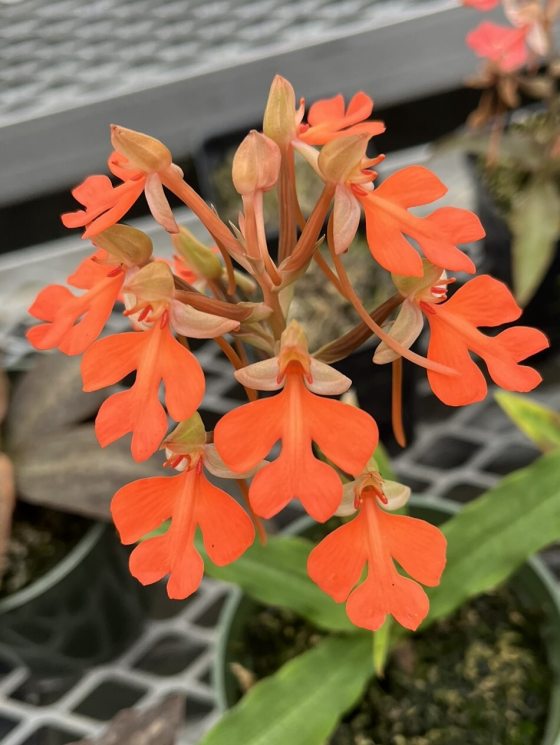
Habenaria Longwood Papaya ‘Longwood’s Coral Crown’. Photo by Greg Griffis.
Now, we will depart from straight Habenaria crosses into the land of × Pectabenaria, which is the nothogenus (a genus derived from a hybrid cross of two or more genera) comprised of Habenaria and Pecteilis. Another genus related to Habenaria that has played an important role in our hybridizing, the genus Pecteilis is a relatively small one, with only 10 species, and only two that are common in cultivation: Pecteilis hawkesiana and Pec. suzannae. Of special import for our work is the species Pecteilis cambodiana, a species never seen in cultivation in the US, but which we have obtained through the work of our Associate Director of Conservation Horticulture and Collections, Dr. Peter Zale. This species has parented two of our new hybrids and will feature in more hybrids as time goes by. All our × Pectabenaria crosses have used Pecteilis cambodiana as one of the parents, and we have registered the first two crosses ever made with it as a parent.
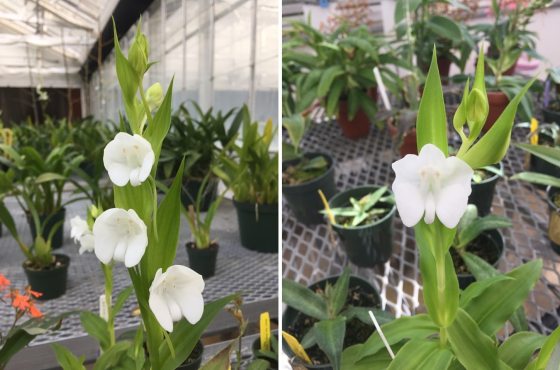
Pecteilis cambodiana ‘Longwood’s Full Moon’ on the left; Pecteilis cambodiana ‘Longwood’s Starlight’ on the right. Photos by Greg Griffis.
The first cross is × Pectabenaria Longwood Snow Dragon. This cross is with Habenaria medusa, which imparts fringes to its offspring. These plants are only on their second flowering, but already they are indicating that we should be able to get tall inflorescences with high flower counts, with flowers spaced evenly along the inflorescence. The flower is, in and of itself, fascinating and interesting, and may very well play a role in the development of more white, fringed hybrids in the future. We will have our seedling group of this hybrid on display for most of September and they are a sight to be seen!
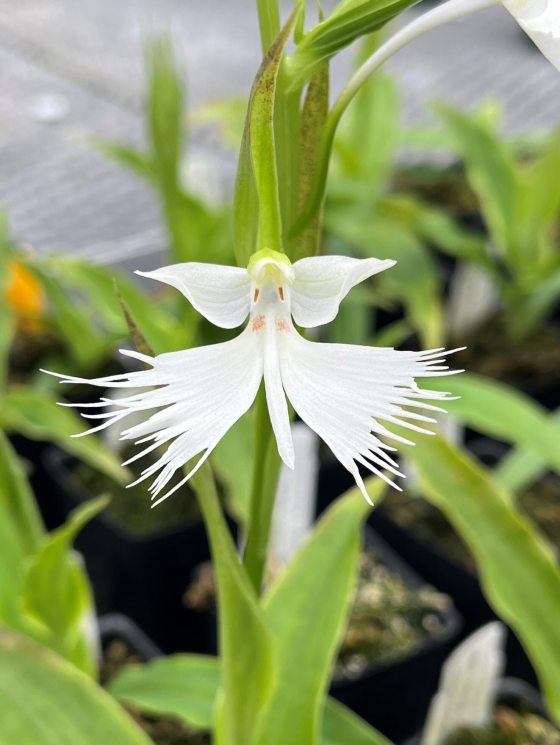
× Pectabenaria Longwood Snow Dragon. Photo by Greg Griffis.
The second × Pectabenaria cross is × Pectabenaria Longwood Pineberry, the name of which references the pale pink/white cultivar of strawberry. It is a hybrid of Habenaria Galah and Pecteilis cambodiana. This cross didn’t yield many seedlings (which is why we will remake it), but this year we should see two of them flower, one which flowered last year, and the second for the first time. All indications are that this hybrid is going to do everything we hoped it would. It should give us large, full-shaped flowers on a sturdy upright inflorescence, with good flower counts (10+ flowers), and good spacing. Of special interest is the shape of the lip, which is a shape not seen in Habenaria before. The influence of the P. cambodiana seems to have been dominant in lip shape, eliminating the typical lobes seen in Habenaria, and giving us a lip that is essentially one lobe. This could open untold doors of possibility in creating new shapes in the Habenaria alliance. Our flowering seedling will be on display for a limited time this year—for about a week in mid-September—before it must return to the greenhouse to grow stronger and go to work on the breeding bench.
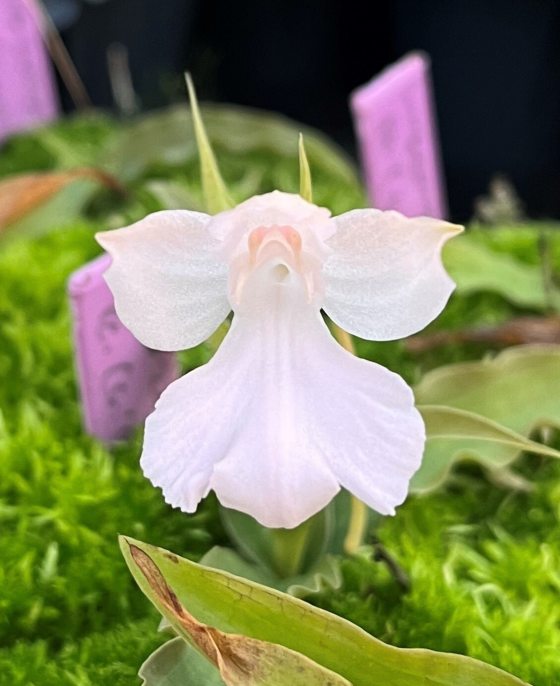
× Pectabenaria Longwood Pineberry. Photo by Greg Griffis.
As if Longwood Pineberry wasn’t exciting enough, there is one more hybrid that is, perhaps, even more exciting. This is a × Cynorkaria cross. Cynorkis is an African genus that is easy to grow with many wonderful flower traits that would benefit our hybrids greatly. To this end, we have been working for many years to make hybrids between Habenaria and Cynorkis, which are the nothogenus ×Cynorkaria.
The first × Cynorkaria hybrid we’ve made is Longwood Passion, and it has yielded three seedlings, all of which have flowered. The first seedling to flower, ‘Longwood’s Pioneer’, was recently awarded an HCC (the equivalent of a bronze medal) by the American Orchid Society. These seedlings represent good traits from both parents, with full-shaped flowers and ease of culture, and will be on display next year.
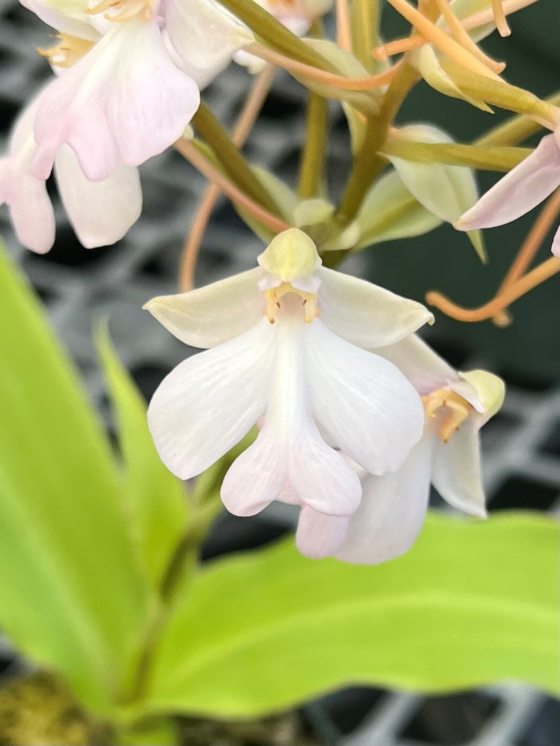
× Cynorkaria Longwood Passion ‘Longwood’s Pioneer’ HCC/AOS. Photo by Greg Griffis.
When it comes to the Habenaria alliance, the future is bright, both literally in the color of the flowers, and figuratively in the incredible amount of work being done here at Longwood and across the orchid world. Within the next several years we hope to register dozens more hybrids to both display and share—and we look forward to sharing more of their beauty with you.
